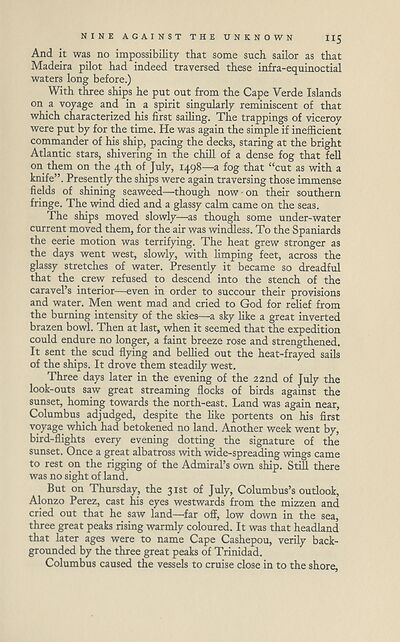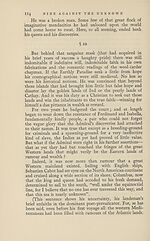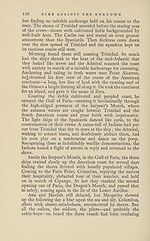Nine against the unknown
(133)
Download files
Complete book:
Individual page:
Thumbnail gallery: Grid view | List view

NINE AGAINST THE UNKNOWN II5
And it was no impossibility that some such sailor as that
Madeira pilot had indeed traversed these infra-equinoctial
waters long before.)
With three ships he put out from the Cape Verde Islands
on a voyage and in a spirit singularly reminiscent of that
which characterized his first sailing. The trappings of viceroy
were put by for the time. He was again the simple if inefficient
commander of his ship, pacing the decks, staring at the bright
Atlantic stars, shivering in the chill of a dense fog that fell
on them on the 4th of July, 1498—a fog that “cut as with a
knife”. Presently the ships were again traversing those immense
fields of shining seaweed—though now • on their southern
fringe. The wind died and a glassy calm came on the seas.
The ships moved slowly—as though some under-water
current moved them, for the air was windless. To the Spaniards
the eerie motion was terrifying. The heat grew stronger as
the days went west, slowly, with limping feet, across the
glassy stretches of water. Presently it became so dreadful
that the crew refused to descend into the stench of the
caravel’s interior—even in order to succour their provisions
and water. Men went mad and cried to God for relief from
the burning intensity of the skies—a sky like a great inverted
brazen bowl. Then at last, when it seemed that the expedition
could endure no longer, a faint breeze rose and strengthened.
It sent the scud flying and bellied out the heat-frayed sails
of the ships. It drove them steadily west.
Three days later in the evening of the 22nd of July the
look-outs saw great streaming flocks of birds against the
sunset, homing towards the north-east. Land was again near,
Columbus adjudged, despite the like portents on his first
voyage which had betokened no land. Another week went by,
bird-flights every evening dotting the signature of the
sunset. Once a great albatross with wide-spreading wings came
to rest on the rigging of the Admiral’s own ship. Still there
was no sight of land.
But on Thursday, the 31st of July, Columbus’s outlook,
Alonzo Perez, cast his eyes westwards from the mizzen and
cried out that he saw land—far off, low down in the sea,
three great peaks rising warmly coloured. It was that headland
that later ages were to name Cape Cashepou, verily back¬
grounded by the three great peaks of Trinidad.
Columbus caused the vessels to cruise close in to the shore,
And it was no impossibility that some such sailor as that
Madeira pilot had indeed traversed these infra-equinoctial
waters long before.)
With three ships he put out from the Cape Verde Islands
on a voyage and in a spirit singularly reminiscent of that
which characterized his first sailing. The trappings of viceroy
were put by for the time. He was again the simple if inefficient
commander of his ship, pacing the decks, staring at the bright
Atlantic stars, shivering in the chill of a dense fog that fell
on them on the 4th of July, 1498—a fog that “cut as with a
knife”. Presently the ships were again traversing those immense
fields of shining seaweed—though now • on their southern
fringe. The wind died and a glassy calm came on the seas.
The ships moved slowly—as though some under-water
current moved them, for the air was windless. To the Spaniards
the eerie motion was terrifying. The heat grew stronger as
the days went west, slowly, with limping feet, across the
glassy stretches of water. Presently it became so dreadful
that the crew refused to descend into the stench of the
caravel’s interior—even in order to succour their provisions
and water. Men went mad and cried to God for relief from
the burning intensity of the skies—a sky like a great inverted
brazen bowl. Then at last, when it seemed that the expedition
could endure no longer, a faint breeze rose and strengthened.
It sent the scud flying and bellied out the heat-frayed sails
of the ships. It drove them steadily west.
Three days later in the evening of the 22nd of July the
look-outs saw great streaming flocks of birds against the
sunset, homing towards the north-east. Land was again near,
Columbus adjudged, despite the like portents on his first
voyage which had betokened no land. Another week went by,
bird-flights every evening dotting the signature of the
sunset. Once a great albatross with wide-spreading wings came
to rest on the rigging of the Admiral’s own ship. Still there
was no sight of land.
But on Thursday, the 31st of July, Columbus’s outlook,
Alonzo Perez, cast his eyes westwards from the mizzen and
cried out that he saw land—far off, low down in the sea,
three great peaks rising warmly coloured. It was that headland
that later ages were to name Cape Cashepou, verily back¬
grounded by the three great peaks of Trinidad.
Columbus caused the vessels to cruise close in to the shore,
Set display mode to:
![]() Universal Viewer |
Universal Viewer | ![]() Mirador |
Large image | Transcription
Mirador |
Large image | Transcription
Images and transcriptions on this page, including medium image downloads, may be used under the Creative Commons Attribution 4.0 International Licence unless otherwise stated. ![]()
| The books of Lewis Grassic Gibbon > Nine against the unknown > (133) |
|---|
| Permanent URL | https://digital.nls.uk/205219671 |
|---|
| Description | Sixteen books written by Lewis Grassic Gibbon (1901-1935), regarded as the most important Scottish prose writer of the early 20th century. All were published in the last seven years of his life, mostly under his real name, James Leslie Mitchell. They include two works of science fiction, non-fiction works on exploration, short stories set in Egypt, a novel about Spartacus, and the classic 'Scots Quair' trilogy which includes 'Sunset Song'. Mitchell's first book 'Hanno, or the future of exploration' (1928) is rare and has never been republished. |
|---|---|
| Additional NLS resources: |
|

